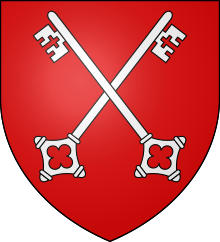Clermont-Tonnerre (noble family)
Clermont-Tonnerre is a noble family of the French aristocracy , attested since the 11th century.
history
It comes from the Dauphiné and takes its name from the small town of Clermont (now part of Chirens ), which is located on a hill near the Lac de Paladru . Not far from Clermont are the ruins of a castle that was built by the early Clermonts in the 12th century. The family's first coat of arms referred to the spelling of the name as Clair-mont , light mountain; the later key coat of arms suggests the form Clefmont .
The family inherited the county of Tonnerre at the end of the 16th century through the marriage between Bernardin de Clermont-Montoison, Viscount de Talart , and Anne d'Husson, Countess of Tonnerre in 1496 ; since then the family name Clermont has been supplemented by the name Tonnerre. The Duchy of Clermont was created in the 16th century in favor of Henri de Clermont and renewed in 1775. The current head of the family is Aynard Jean Marie Antoine, Duc de Clermont-Tonnerre (* 1962).
The house of Clermont-Tonnerre is to be distinguished from the house of Clermont in the north of France .
The Clermont in the Dauphiné
The first known Clermont is Sibaud I, Seigneur de Clermont et de Saint-Geoire (now in the Isère department ), participant in the First Crusade . He owned at least eight castles, including Saint Geoire , Montferrat , Chirens and Châbons . He married Adélaïs d'Albon, daughter of the Dauphin von Viennois and granddaughter of Emperor Heinrich III. and Agnes of Poitou .
At this time the Kingdom of Burgundy was in the process of dissolving, the later Dauphiné had disintegrated into various independent areas that were formed or enlarged at the expense of the kingdom. The new principalities were founded by the nobility and the clergy: the Archbishop of Embrun and the Bishop of Grenoble ruled as princes, the Archbishop of Vienne and the Bishop of Valence , the Bishops of Valence , Gap and Die as counts, each with a considerable number of vassals . Among the secular princes it is the Counts of Albon and later Dauphins of Viennois, the Counts of Savoy , Salmorenc, Valentinois and Diois , the La Tour-du-Pin , Clermont, Sassenage , Mévouillon and Montauban families who are on an equal footing with each other encountered: in all treaties that the Clermonts signed up to 1340, they appear with the Dauphins and the Savoyers without any difference in rank.
Only Savoy, Diois and Valentinois survived the 14th century in this form. The others gradually lost their independence, often through violence, and submitted to the three others. The Clermonts were the last to renounce their rights. The contract, which subordinated the property of the Clermont to the Dauphin, dates back to 1340 - however, the Baron of Clermont was appointed Premier Pair, Connétable and hereditary grand master of the Dauphiné, so that the Baron of Clermont held the second highest rank in the Dauphiné .
The Clermont at the royal court
The family managed to save their rights in the union of the Dauphiné with France. Henri de Clermont, Duc de Clermont and Pair de France since May 1, 1571 (confirmed by the Parliament on June 10, 1572) would have inherited the Pairie to his descendants if, due to an error in the registration by the Parliament, this honor had not been granted upon his death Would have expired in 1573. In 1775 the Duchy of Clermont-Tonnerre was rebuilt for Gaspard de Clermont-Tonnerre , Marshal of France .
François Joseph de Clermont-Tonnerre had to sell Tonnerre County in 1684 for financial reasons. The buyer was Louvois
Castles of the Clermont
- Ancy-le-Franc ( Yonne ) castle , built from 1544 to 1550 in the Renaissance style according to plans by Sebastiano Serlio
- Maulnes Castle ( Yonne ), built 1566 to 1573
- Bertangles Castle ( Somme ), inherited in 1611



